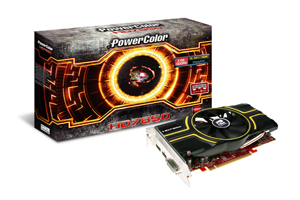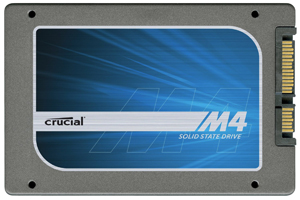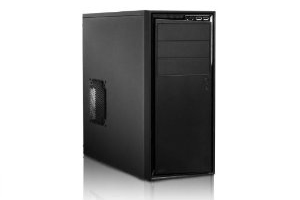SSD ME…SCOTTY
I have not made a recommendation for any SSD in this build due mainly to two factors. Firstly, space considerations. At the current prices, we could sneak in a lower end and smaller capacity SSD. This would mean needing to install a separate hard drive for actual storage space, which means more money. Or we could put in a 128GB version for around the same price as the solution proposed above. But either way, we end up blowing the budget without achieving any particularly significant improvements.
End result: very limited storage space, or relying on a hard drive anyway, and limited performance gains.
Secondly, system bottlenecking. The reason SSDs make sense in build with a bit more money to splash around is that they remove one of the largest bottlenecks once a certain level of performance is reached. Once you get to that plateau, your dollar invested in either processing power (CPU) or graphics (GPU) net you less and less performance gains compared to what you could get by investing in a SSD. Imagine you are in a race to fill a bucket with water. The water must be fetched by cup from a tap. The cup takes 5 seconds to be filled from the tap before you can run over and dump it into the bucket.
If it took you 1 minute to run to the bucket and back to get another cup, that 5 second filling time is the least of your worries. You would be better off figuring out how to get the water back to the bucket faster than worrying about that 5 seconds. But imagine if you could magically teleport to the bucket and back instantaneously. Then, that 5 seconds starts to be 100% of the time you are waiting and the only way for you to get any faster is to get that cup full quicker. That example is a little contrived, but the basics are there nevertheless. Priorities people, priorities. In this budget gaming system, especially with the performance offered by the WD VelociRaptor, that money could be better spent on more processing power.
ALTERNATIVES
Crucial m4 128GB SSD – $109.99
If you are still determined to get yourself an SSD after all that, then I would have to recommend the Crucial m4 at this point in time.
SSDs are a little trickier than hard drives, the most important feature I would argue is reliability.
It doesn’t matter how many points an SSD scores in benchmarks, or if it has the highest transfer speeds if you wake up and find all you data gone tomorrow. The m4s have been used and recommended in many places because they have done hard yards in many systems under abnormal load situations as hardware testers and reviewers play with them; And they still keep trucking on.Having been around for a while now, they have endured in a lot of systems out in the wild and in hardware test labs.You can’t get a stronger recommendation than that.
For a more value oriented system, the 64GB m4 in tandem with one of the above mentioned drives would be a very nice combination. If you are good and hold you usage down, and can do without the extra hard drive, the 128GB m4 might just find its way into your life. Or at the very least, your gaming box.
GATHERING GRAPHICS CARDS
PowerColor 2GB GDDR5 Radeon HD 7850 Gfx Card – $184.99
 The value of the Radeon 7850 chipset offers at the under $200 price point is out of this world.
The value of the Radeon 7850 chipset offers at the under $200 price point is out of this world.
This is what allows us to push Battlefield 3 to 1080p with most settings turned right up even in this modest budget system.
It represents a significant part of the whole budget, but worth every cent. This is where the dollars we have painstakingly scraped off in other areas get used up.
In terms of benchmark and ingame performance, the 7850 represents the current sweet spot. The PowerColor implementation is a simply laid out version with a cooling shroud and fan. Perfect for our budget system.
ALTERNATIVES
This section on graphics cards alone could be turned into a full article and then some. To avoid circling, lets just agree on a few points in general. Graphics card discussions come down to what performance at what price. Currently, that positions 7850 based cards very competitively. Prices can and do change, hence this may change as well.
There are many implementations of the 7850 by many vendors. Pick one from a company with a solid reputation, they will be relatively similar. Just watch out for overclocked and 1GB cards. The overclocks draw a premium price and that might throw their value proposition out. The 1GB cards are around $10 cheaper generally, don’t limit yourself for that reason. Performance at higher settings and resolutions do make use of that additional memory.
Asus, HIS, Gigabyte are just some of the brands that I personally like.
There are viable solutions in the NVidia camp too. The 7850 wins on overall performance compared to the cost. You are certainly free to choose a GTX model should you be so inclined, just adjust your budget accordingly and wonder what else you could have done with that money instead.
NZXT Source 210 – $31.99(Black)
NZXT makes a solid case. Looks reasonably attractive without overdoing it, sensible layout inside, good airflow, good build quality, very reasonably priced.
ALTERNATIVES
Very much a personal choice here. In the interests of sticking to the budget, this was my pick that I believed would appeal generally to most readers. Feel free to go cheaper if you wish, or to go to town. The big thing to watch out for regardless of which case gets your attention would be good airflow. We want to make life simple, and having good ventilation to get all that heat out of the case allows us to stick with stock coolers and fans.
A case that allows for the power supply to be mounted at the bottom would be the best.
 Technology X Tomorrow's Technology Today!
Technology X Tomorrow's Technology Today!



